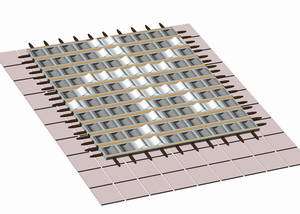New graphic displays for the blind

The micro robotic group at the caesar research center has recently been awarded one of three research prizes by the ONCE foundation in Madrid. The ONCE foundation is dedicated to the social integration of the handicapped and blind in particular. With this EUR 60,000 prize, the Spanish organization acknowledges the invention of a new mechanism for graphical tactile displays for the blind by the researchers Dr. Bernhard Winzek, Dr. Sam Schmitz and Roman Vitushinsky, thus promoting the technical implementation of this principle.
Image: One single module with 10 x 10 metallic films. Graphic: Caesar
María Jesús San Segundo, Spanish Secretary of Education and Science, and Carlos Rubén Fernández, President of ONCE foundation, awarded the prize to the scientists at the historical Complutense University auditorium in Madrid. Georg Boomgaarden, German Ambassador to Spain, also participated in the festive award ceremony.
The displays use metallic films featuring various shape memory alloys which are produced layer by layer on silicon wafers using thin film technology. Display pixels are generated when the metallic film adjusts its curvature partially, similarly to bimetal snap plates for temperature switches. The movement of the films is then transferred to the touch panel via plastic pins und thus can be detected by the user. The combination of shape memory alloys is innovative. It enables switching the film to stable positions using different heat pulses without a permanent heat supply. Thus, only the switching operation requires electric current, whereas maintaining the status does not.
The benefits vis-à-vis traditional Braille displays are the display’s compact structure featuring thin film technology, resulting in a cost reduction per pixel. Using conventional Braille-cell technology, costs for the graphic display of information emerging from the high number of pixels required are beyond the price range of the blind. With these innovative displays scientists make a significant contribution to the freedom in daily life of the handicapped.
The Bonn-based international research center caesar (center of advanced european studies and research) commenced research in 1999. With over 220 employees, interdisciplinary teams conduct research in the areas of biotechnology, nanotechnology and medical technology. Research and industrial application cooperate smoothly: caesar develops innovative products and procedures, and supports scientists in initiating new ventures.
Source: Caesar















